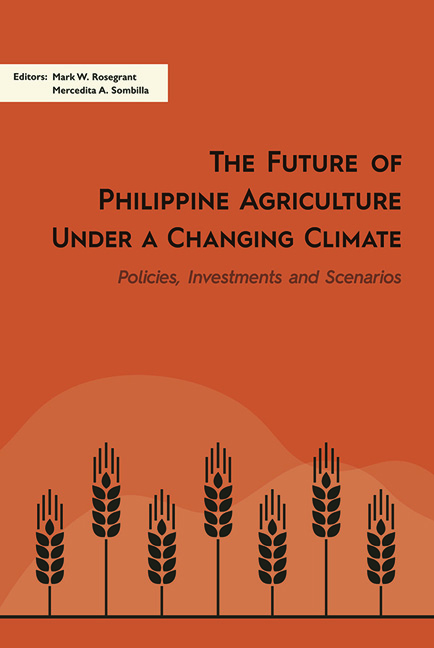Book contents
- Frontmatter
- Contents
- List of Tables
- List of Figures
- List of Appendices
- Preface
- Acknowledgements
- List of Contributors
- PART I Setting up the Scenarios: Current Status and Potential Impacts of Climate Change to Philippine Agriculture
- 1 Current Structure and Future Challenges of the Agricultural Sector
- 2 The Context of Land Cover Changes in Agriculture and Forestry
- 3 Trends in Agricultural Water Resources
- 4 Existing Evidence of Climate Change and Variability
- PART II Climate Change Adaptation Strategies and Sustainability of Philippine Agriculture
- PART III Investments and Supporting Policies to Alleviate Climate Change Impacts to Philippine Agriculture
- PART IV Conclusion
- Index
1 - Current Structure and Future Challenges of the Agricultural Sector
from PART I - Setting up the Scenarios: Current Status and Potential Impacts of Climate Change to Philippine Agriculture
Published online by Cambridge University Press: 29 May 2019
- Frontmatter
- Contents
- List of Tables
- List of Figures
- List of Appendices
- Preface
- Acknowledgements
- List of Contributors
- PART I Setting up the Scenarios: Current Status and Potential Impacts of Climate Change to Philippine Agriculture
- 1 Current Structure and Future Challenges of the Agricultural Sector
- 2 The Context of Land Cover Changes in Agriculture and Forestry
- 3 Trends in Agricultural Water Resources
- 4 Existing Evidence of Climate Change and Variability
- PART II Climate Change Adaptation Strategies and Sustainability of Philippine Agriculture
- PART III Investments and Supporting Policies to Alleviate Climate Change Impacts to Philippine Agriculture
- PART IV Conclusion
- Index
Summary
After a period of lacklustre performance in the 2000s, the Philippine economy improved considerably during 2010–14. The Aquino Administration (2010–16) has anchored a platform of sustainable and inclusive growth that incorporates fighting corruption, pursuing peace and order, and instituting governmental reform. Average yearly growth during 2010–14 was 6.2 per cent — the country's highest five-year average in forty years (peaking at 7.2 per cent in 2013). This pace of growth has put the country among the fastest growing developing economies in the world, resulting in unprecedented upgrades in credit and investment ratings. Progress, however, is slower in the social sector. Poverty is high and, so far, has responded sluggishly to economic growth. Underemployment also remains high at close to 20 per cent. Clearly, much work remains to be done.
Sustaining economic growth over the medium to long term requires structural transformation — especially involving a shift from low-productivity areas and sectors to high ones. Raising agricultural productivity is a key contributor. Although agriculture's share of the economy has continued to decline with economic development, enormous opportunities exist for income growth and poverty reduction in response to rapidly changing Asian food markets. Nevertheless, policy and governance constraints have limited Filipino farmers’ ability to seize these opportunities. Basic reforms are required to facilitate and strengthen agriculture's contribution to the Philippine economy.
This chapter provides an overview of the patterns, composition, policies, and institutional framework that have influenced the performance of the agricultural sector in recent years. The focus is the changing dynamics of agricultural supply and demand — as a whole and for key commodities — in the context of a growing economy, urbanization, and regional market integration. The chapter concludes with a discussion of the policy and institutional challenges inherent in enabling agriculture to form a key pillar in the country's pursuit of inclusive growth, poverty reduction, and sustainable development.
AGRICULTURE IN THE CONTEXT OF STRUCTURAL TRANSFORMATION
The decline of agriculture in response to economic development has been widely documented in the literature following the works of Clark (1940), Kuznets (1966), and Chenery and Syrquin (1975), using both cross-sectional and time-series data. The pattern is quite “uniform and pervasive” (Timmer 1988, p. 276), be it in socialist or capitalist countries in Asia, Latin America, or Africa.
- Type
- Chapter
- Information
- The Future of Philippine Agriculture under a Changing ClimatePolicies, Investments and Scenarios, pp. 3 - 70Publisher: ISEAS–Yusof Ishak InstitutePrint publication year: 2018



